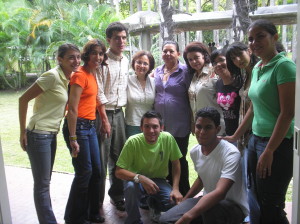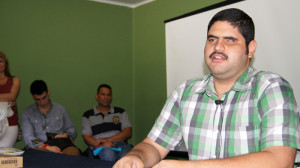Different Abilities: Embracing and Supporting Diversity at the University
As member of a committee, I have been providing support to students with disabilities or functional diversity for some good 10 years at a public university in Venezuela. The term “special needs” is generally used for students in primary or high school. Even the term “functional diversity”, as appealing and inclusive as it is, has raised some controversies in our country since it would mean changing labels, laws and attitudes and it may also endanger the visibility disabled people have gained over the past years. For some people, they would become diluted within a diverse society that has traditionally valued able-bodiedness risking the attention disabled people have received so far. Ironically, this term was coined by a Spanish tetraplegic Javier Romanach, one of the founders of the Diversity and Independent Living Forum from Spain.

As a teacher more than how our disabled students should be called, labeled, or fit into a medical or social approach, I do care more for the support they need to study in the School of Librarianship in the Faculty of Humanities and Education at Universidad Central de Venezuela (UCV). That’s what I try to do as a member of a Committee for the Integration of Disabled Students from the School of Librarianship (CAEDEBA). We offer academic help and guidance to these students. Also this committee – made up of 12 disabled students, 10 volunteers and 2 teachers – organizes workshops and events to sensitize our community about disability. This semester 2 deaf students will start studying this career and we are figuring out how to get Venezuelan sign language interpreting services in the classroom. Here are some tips I’d like to share with you when teaching students with different disabilities:
Asperger’s syndrome (autism spectrum disorder):
One Asperger can be totally different from another one. They may sound even different as if they had picked up a foreign accent. Some of them sound words and phrases carefully and may repeat what they say several times. It is true they function pretty well under a well structured environment. Also it is difficult for them to understand metaphors or jokes. They can be socialized though. Have you ever heard about Sheldon from the Big Bang theory? In our school, one of our Asperger students is about to graduate. Two more are just starting this career. Based on my experience, what would be my advice?
- If you use metaphors or tell jokes in the classroom, explain what you tried to say. You can paraphrase, illustrate or give their literal meaning.
- Always let Aspergers know you are going to change lesson plans, class schedule or even seating arrangement. Some of them may feel threatened when things are suddenly changed. They may relentlessly hurt themselves under stress.
- Let them know there is a safe place at the university they may go to when they feel under stress: teachers’ office, university counselor, support group.
- Some Asperses may try to find their way around to justify not having studied or having finished a task. This doesn’t mean they don’t want to do the task or study. This is a hidden message telling you they might feel under pressure or it is not clear to them what they are required to do. Check what the cause of the anxiety is- if it is not classroom-related and you don’t know what to do get some advice from the university counselor or support group.
Blind students

We should always know if the student has total blindness or low vision. This will determine the type of help students may need. If it is total blindness they need to know how to use Braille or a screen reading software (eg. Jaws). They may also need some assistance to get around. Now be careful they would prefer to do this on his/her own. Partially sighted students may need magnifying glasses or having the font size of tests and materials changed. My advice:
- Check out what type of assistive technology students may need to read, take notes or tests (e.g. Braille, Jaws, laptop).
- For students with complete blindness, in a test situation it is always fair to give them a head start (about 15 minutes) before their classmates.
- For students with low vision, print out materials / tests with the most suitable font size (generally 21 to 25).
- It is a good idea to send materials, tasks, readings to these students’ emails in advance.
- Blind students may need to record the class lecture or discussions.
We have two low vision students and one complete blind student. They have never used Braille but it is always good for them to know if there is a place in the university where they can get assistive or adaptive technology to help them study, print material or even get equipment loans.
Deaf students using hearing device (Hypoacusia)
In our school, there is a partially deaf student currently working on her thesis. She uses a hearing device. What’s my advice this time?
- Make sure you talk to the student face to face and depending on the level of hearing loss speak slightly slower. Don’t talk to him/her as if they were dumb , though.
- Make sure he/she seats in the front row.
- They will generally have writing or reading problems. So they may need guidance on how to improve these skills at the university. You can also refer them to student unit services where they will learn about reading or writing courses they may enrol in.
- Deaf students may need to record the class lecture and discussions.
Students with reduced mobility

In our school, there’s a group of students with reduced mobility in their hands and legs, but they do not use wheelchairs. One of them uses a walking frame. One of the main things we have to consider is facilitating accessibility. Most students with reduced mobility in their hands may need:
- Extended time to start a test since it may take some time for them to answer questions or write essays, for example. Another option is for them to take oral tests instead of written ones.
- This may vary from one culture to culture, but it is always a good idea to make sure these students have a classmate who may take notes for him/her or share his/her notes with these students.
- These students may need to record the class lecture and discussions.
- Make sure there’s a fixed seat for these students in the front row and space is clear from obstacles or clutter.
Students with reduced mobility are benefitted by adaptive technology used by blind people.
Learning and psychiatric disabilities
In our school, we have also dealt with students with learning and psychiatric disabilities. In the case of learning disabilities students may need extended time when taking tests or substituting written tests for oral ones. They may benefit from repetition and reviewing content in each class (able-bodied students will benefit from this as well). Instructions should be clear and teachers should make sure this is so (follow-up). They forget or misunderstand instructions easily. This may happen to able-bodied students too, but in the case of students with learning disabilities this might be amplified. Psychiatric cases should be dealt carefully- teachers had better get support from university counselors or psychologists.
In our country, disable students can have a place at the university from different modality entrances just like any able-bodied student, except for the so called OPSU-disability university entrance. Once they are part of our community they should receive support. This doesn’t mean special treatment, but promoting inclusive and equitable opportunities for them to thrive during their undergraduate studies. In this journey of disabled students becoming part of the university community, they have an important role to make themselves visible and proud of who they are. Otherwise, efforts from members of this community will not resonate as much as it is needed to embrace and support them in an environment that sometimes can be hostile and framed within old scholar values of what a “normal, smart” student should be.


You are doing such an important thing by promoting the accessebility of higher education! If there is any help I can offer, as a national counselor of the deaf and hard of hearing (albeit from across the waters) don’t hesitate to ask.
For example, did you know that many hard of hearing and deaf students prefer to sit a bit at the side of the class, second row, and not dead center front row? Not only is it a better angle for lip reading (better called message reading) it is easier for the student to turn in his/ her seat to see the class when a student is speaking.
Naomi (@naomishema)
Hi Miguel! I am excited to learn of your expertise in working with persons with disabilities, as I know you from the field of EFL. I recently was assigned to an accessibility team of instructional designers at my university. I’ve been working on a chart of media specifications for making online learning accessible. I would love to share it with you and get some feedback. The media specs for information technology are aligned with the US govt standards (Section 508) for accessibility. (P.S. I found this article on Dolores’ Scoopit.)
Your EVO friend, Sandra (@teacherrogers)
Hi Naomi.
It is really great to know you are a national counselor for the deaf and hard of hearing and thanks for the advice. Last week two deaf students started classes in our School. They are sitting front row and getting help from a sign language interpreter. We are also planning on starting a video project to record new signs and basic ones needed about the university. This will not only benefit these students and their community, but teachers and students willing to communicate with them (Integration).
Best of luck with this! If you need to talk – let me know!
Naomi (@naomishema)
Thanks Naomi!
Hi Sandra,
Yes! I’d like to have a peek at this chart of media specification. Sounds really interesting.
Will write to you soon…
Your EVO friend,
Miguel:)